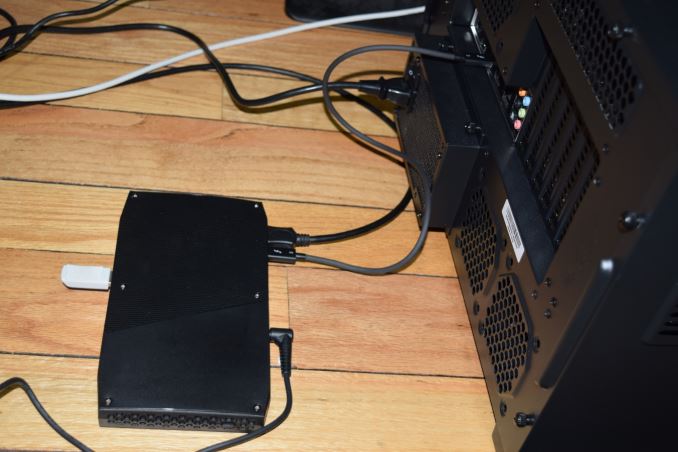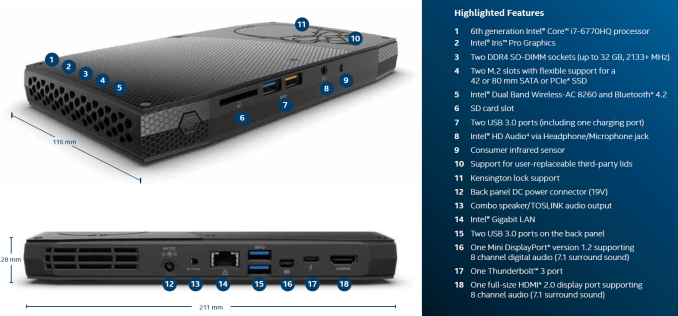
Original Link: https://www.anandtech.com/show/10343/the-intel-skull-canyon-nuc6i7kyk-minipc-review
The Intel Skull Canyon NUC6i7KYK mini-PC Review
by Ganesh T S on May 23, 2016 8:00 AM EST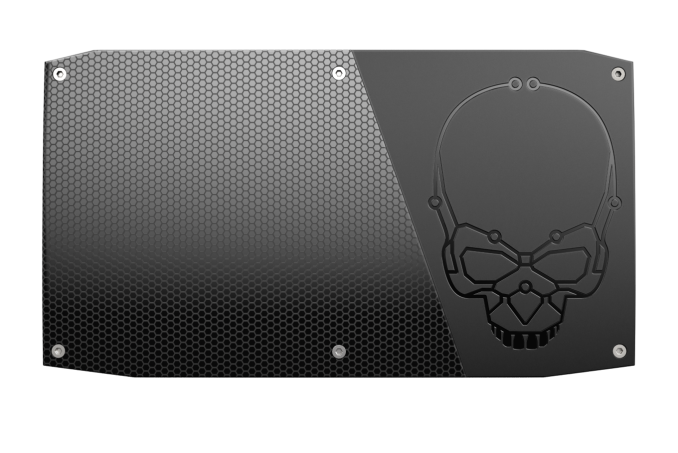
The desktop computing market as a whole has been subject to severe challenges over the last few years. The ultra-compact form-factor (UCFF) PC market that emerged with the introduction of the Intel NUCs (Next Unit of Computing) has been one of the few bright spots. PC gaming has been one of the few other markets that has withstood the overall issues. The small size of UCFF PCs usually made discrete GPUs difficult to integrate, and iGPUs have not impressed the gaming crowd. Therefore, the market has not seen many products targeting the gaming market while also being compact. This year, we have a new entrant in that category - Intel's Skull Canyon NUC, the NUC6i7KYK, places a 45W TDP Core i7-6770HQ with Iris Pro graphics in a chassis around twice the size of the standard NUC.
Introduction
In the course of our coverage of mini-PCs, we have seen offerings from vendors such as ASRock, GIGABYTE and Zotac targeting the gaming market. Usually, 'mini' doesn't fit the requirements of consumers in this space, but the appearance of power-efficient high performance GPUs have made the offerings in the gaming mini-PC space quite interesting. The Intel Skull Canyon NUC6i7KYK aims to go one step further by taking the discrete GPU out of the equation and reducing the size of the system as compared to the ASRock VisionX and Zotac ZBOX E-series units.
Skull Canyon has a slightly bigger footprint compared to the traditional NUCs, coming in at 211mm x 116mm x 28mm (compared to the 115mm x 111mm x 32mm of the NUC6i5SYK). Unlike the plain industrial design of the traditional NUC chassis, Skull Canyon goes for slightly more stylish design. The default lid comes with a skull logo on top (Intel's products targeting the gaming market have traditionally included that logo), though the package also includes a lid without the logo. Additional items in the kit include a VESA mount and screws for the same, as well as a 120W (19V @ 6.32A) power brick with a separate power cord. A quick-start manual provides directions on how to add memory and SSDs to the unit.
Intel provided us with an engineering sample of the NUC6i7KYK with DDR4 SODIMMs and a M.2 SSD pre-installed. The specifications of our review unit are summarized in the table below.
| Intel NUC6i7KYK (Skull Canyon) Specifications | |
| Processor | Intel Core i7-6770HQ Skylake-H, 4C/8T, 2.6 GHz (Turbo to 3.5 GHz), 14nm, 6MB L2, 45W TDP |
| Memory | Micron 16ATF1G64HZ-2G1A2 DDR4 15-15-15-36 @ 2133 MHz 2x8 GB |
| Graphics | Intel Iris Pro Graphics 580 |
| Disk Drive(s) | Samsung SSD 950 PRO (512 GB; M.2 Type 2280 PCIe 3.0 x4 NVMe; 40nm; MLC V-NAND) |
| Networking | Intel Dual Band Wireless-AC 8260 (2x2 802.11ac - 866 Mbps) Intel Ethernet Connection I219-LM GbE Adapter |
| Audio | 3.5mm Headphone Jack Capable of 5.1/7.1 digital output with HD audio bitstreaming (HDMI) |
| Miscellaneous I/O Ports | 4x USB 3.0 1x Thunderbolt 3 / USB 3.1 Gen 2 1x SDXC |
| Operating System | Retail unit is barebones, but we installed Windows 10 Pro x64 |
| Pricing (As configured) | $1027 |
| Full Specifications | Intel Skull Canyon NUC6i7KYK Specifications |
The Intel NUC6i7KYK (Skull Canyon) kit doesn't come with any pre-installed OS. Our evaluation was done with Windows 10 Pro x64, with all the latest patches installed. All the drivers, except for the GPU, were downloaded off the Skull Canyon product page. The latest GPU drivers for the Iris Pro Graphics 580 were downloaded from the GPU-specific page. The gallery below shows the various features of the chassis as well as the teardown pictures for lid replacement / memory / SSD installation.
Important aspects to note in the above pictures include the USB 3.0 header visible in the opening beneath the top lid (perfect for third-party lids to take advantage) and the WLAN antennae glued to the top on the front side. It is heartening to see Thunderbolt back after its first and only appearance in the first-generation NUC. The dual M.2 slots are also interesting, and this brings us to the next topic - the board layout.
Platform Analysis and BIOS Features
The NUC6i7KYK uses a Skylake-H CPU in conjunction with the H170 platform controller hub (PCH). The board layout (how the various I/Os communicate with the CPU) is shown below. Of particular interest is the placement of the M.2 slots and the Alpine Ridge Thunderbolt 3 controller.
It is good to see that the SDXC slot is enabled by a PCIe SD card controller (PCIe x1), and not via a USB 2.0 bridge. Intel specifies support for UHS-I speeds. The two M.2 slots are off the PCH. This is understandable since the SATA links that must be multiplexed with the PCIe lanes are going to come off the PCH and the high-speed I/O lanes are shared.
The disappointing aspect here is that the Alpine Ridge controller hangs off the PCH, and not the CPU. Given that a dGPU can only be attached to the system via the Thunderbolt 3 port, it would have made sense to connect it direct to the CPU. This also means that all the high-speed peripherals that can be attached to the NUC6i7KYK are bottlenecked by the DMI 3.0 link between the CPU and the PCH when it comes to exchanging data with the CPU. In the Skylake-H / H170 setup, this link is effectively PCIe 3.0 x4 in terms of bandwidth.
Moving on to the BIOS features, the gallery below presents some screenshots of Intel's VisualBIOS for the NUC6i7KYK.
The important default setting to note is that the performance mode is set to 'Balanced Enabled'. Other options include 'Low Power Enabled' and 'Max Performance Enabled'. The user interface as well as other settings are quite similar to what we saw in the Skylake NUC review, except that the Skull Canyon BIOS has settings specific to the second M.2 slot and the Thunderbolt port.
In the table below, we have an overview of the various systems that we are comparing the Intel NUC6i7KYK (Skull Canyon) against. Note that they may not belong to the same market segment. The relevant configuration details of the machines are provided so that readers have an understanding of why some benchmark numbers are skewed for or against the Intel NUC6i7KYK (Skull Canyon) when we come to those sections.
| Comparative PC Configurations | ||
| Aspect | Intel NUC6i7KYK (Skull Canyon) | |
| CPU | Intel Core i7-6770HQ | Intel Core i7-6770HQ |
| GPU | Intel Iris Pro Graphics 580 | Intel Iris Pro Graphics 580 |
| RAM | Micron 16ATF1G64HZ-2G1A2 DDR4 15-15-15-36 @ 2133 MHz 2x8 GB |
Micron 16ATF1G64HZ-2G1A2 DDR4 15-15-15-36 @ 2133 MHz 2x8 GB |
| Storage | Samsung SSD 950 PRO (512 GB; M.2 Type 2280 PCIe 3.0 x4 NVMe; 40nm; MLC V-NAND) |
Samsung SSD 950 PRO (512 GB; M.2 Type 2280 PCIe 3.0 x4 NVMe; 40nm; MLC V-NAND) |
| Wi-Fi | Intel Dual Band Wireless-AC 8260 (2x2 802.11ac - 866 Mbps) |
Intel Dual Band Wireless-AC 8260 (2x2 802.11ac - 866 Mbps) |
| Price (in USD, when built) | $1027 | $1027 |
Performance Metrics - I
The Intel NUC6i7KYK (Skull Canyon) was evaluated using our standard test suite for low power desktops / industrial PCs. Not all benchmarks were processed on all the machines due to updates in our testing procedures. Therefore, the list of PCs in each graph might not be the same. In the first section, we will be looking at SYSmark 2014, as well as some of the Futuremark benchmarks.
BAPCo SYSmark 2014
BAPCo's SYSmark 2014 is an application-based benchmark that uses real-world applications to replay usage patterns of business users in the areas of office productivity, media creation and data/financial analysis. Scores are meant to be compared against a reference desktop (HP ProDesk 600 G1 with a Core i3-4130, 4GB RAM and a 500GB hard drive) that scores 1000 in each of the scenarios. A score of, say, 2000, would imply that the system under test is twice as fast as the reference system.
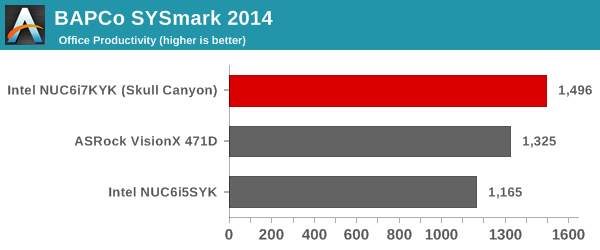
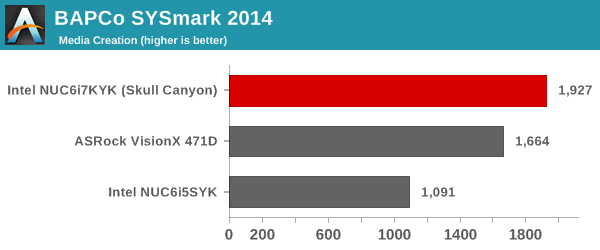
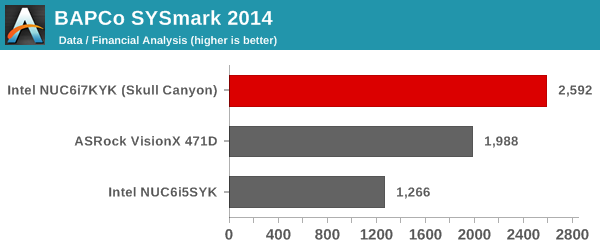
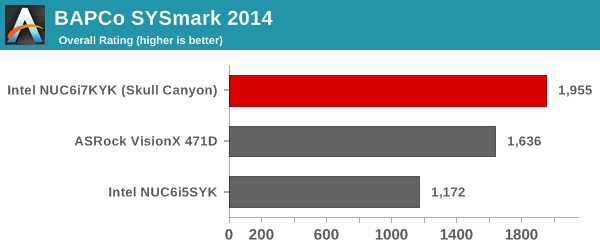
We started using SYSmark 2014 quite recently, which is the main reason for the absence of many of the comparison systems in the above graphs. In any case, the most interesting of the compared lot when it comes to CPU-intensive benchmarks like SYSmark 2014 is the ASRock VisionX 471D, equipped with a Core i7-4712MQ processor. We can see that the Core i7-6770HQ-based Skull Canyon NUC6i7KYK is miles ahead of the other two systems when it comes to office / business workloads. Readers interested in comparing the SYSmark 2014 scores for systems based on other CPUs can peruse the Bench results here.
Futuremark PCMark 8
PCMark 8 provides various usage scenarios (home, creative and work) and offers ways to benchmark both baseline (CPU-only) as well as OpenCL accelerated (CPU + GPU) performance. We benchmarked select PCs for the OpenCL accelerated performance in all three usage scenarios. These scores are heavily influenced by the CPU in the system. As expected, the Core i7-6770HQ enables the NUC6i7KYK to easily come out on top in the charts.
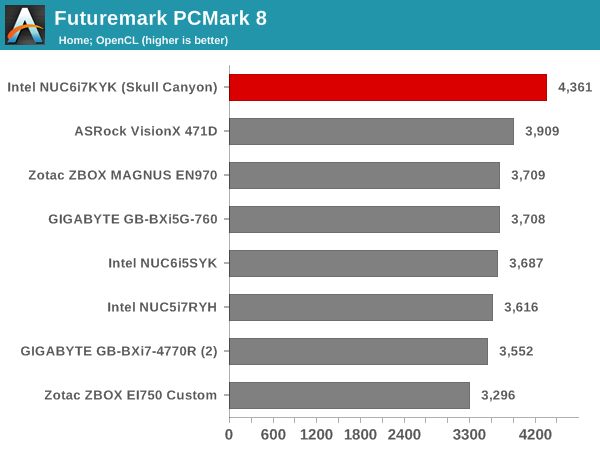
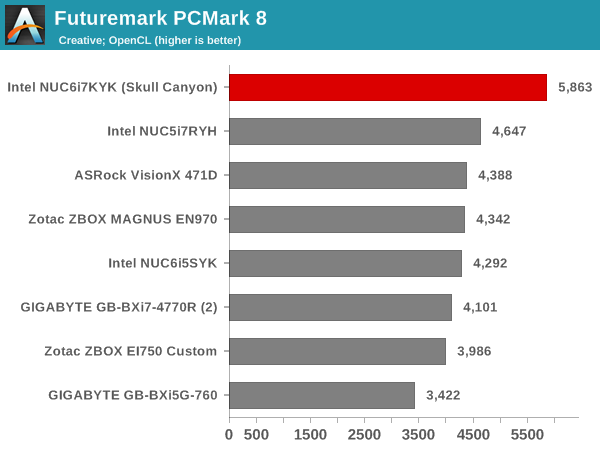
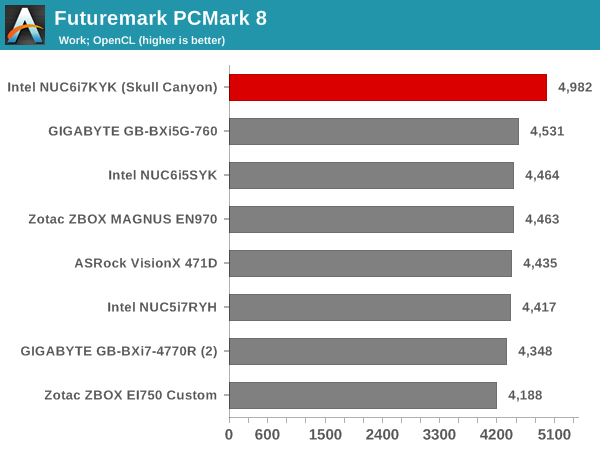
Miscellaneous Futuremark Benchmarks
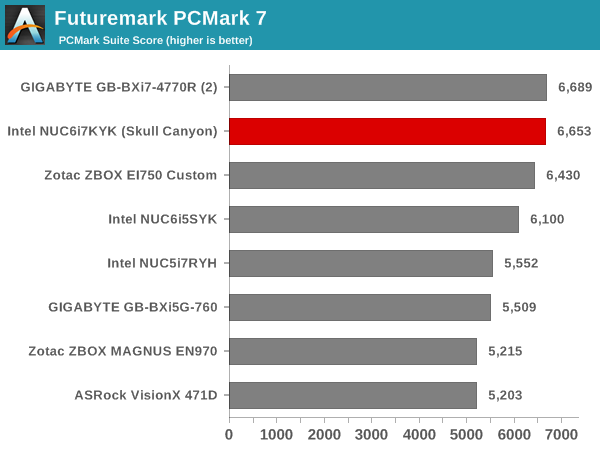
The graphics benchmarks present a different story, though. In these, the NUC6i7KYK does perform well enough to come in the top half. However, in scenarios which are not CPU-bound, the systems equipped with discrete GPUs easily turn out to be better than Skull Canyon.
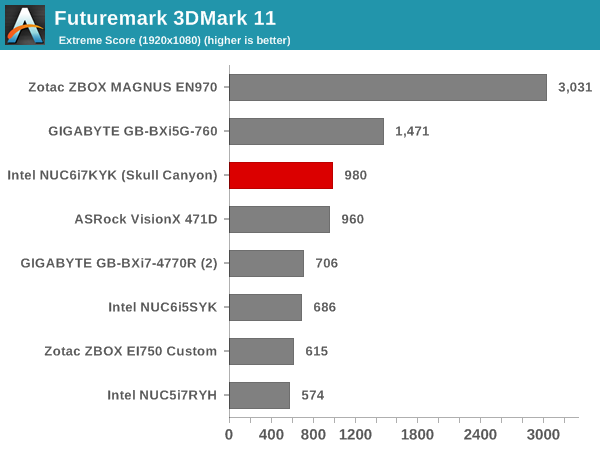
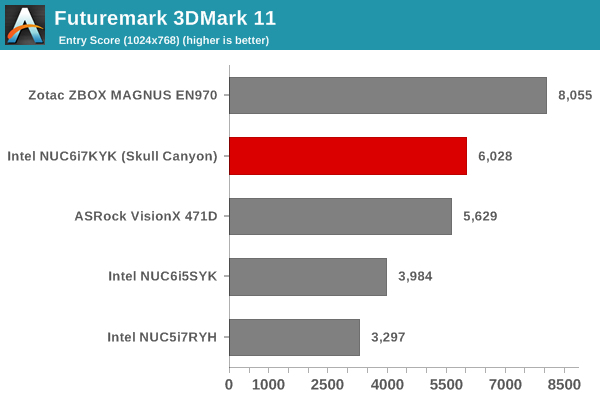
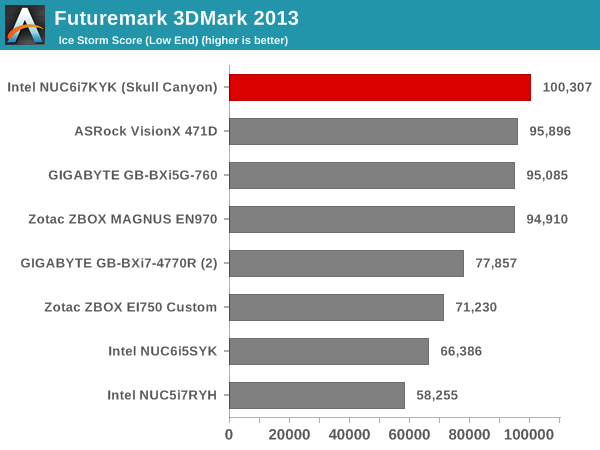
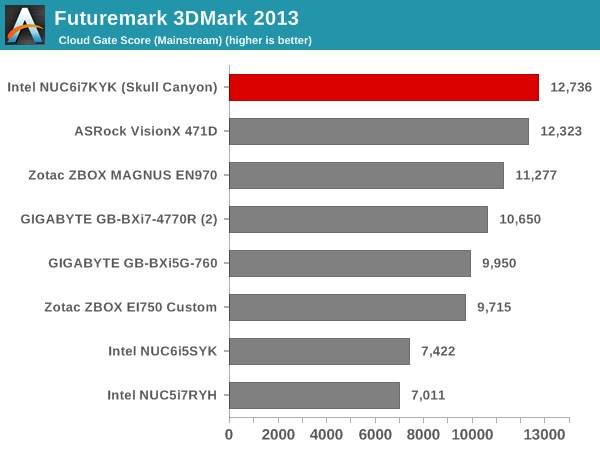
3D Rendering - CINEBENCH R15
CINEBENCH R15 is a standard benchmark for 3D rendering. It provides three benchmark modes - OpenGL, single threaded and multi-threaded. Evaluation of select PCs in all three modes provided us the following results.
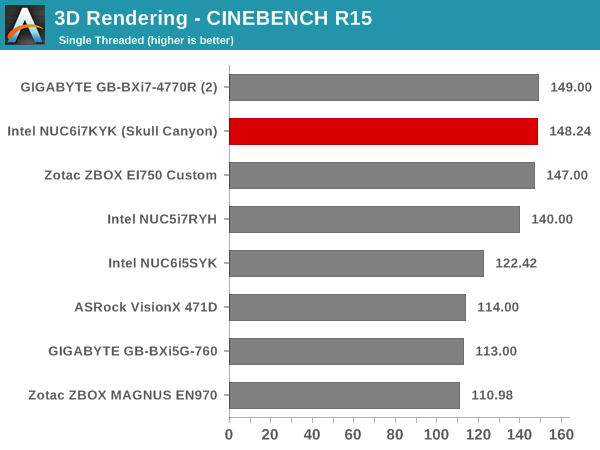
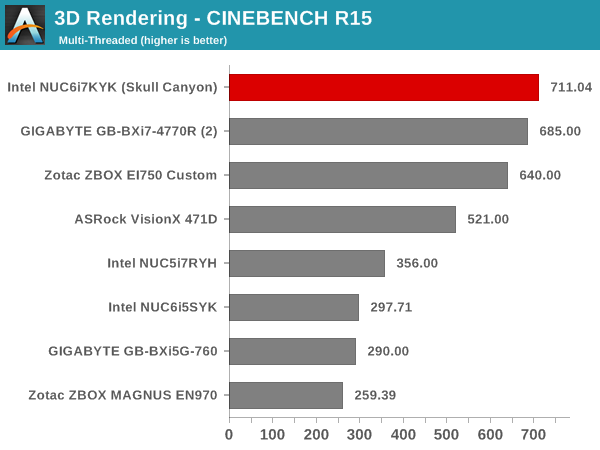
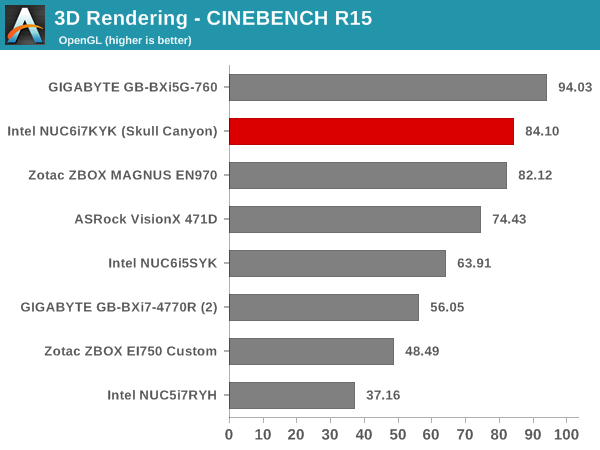
In the single-threaded case, the Core i7-4770R (a 65W TDP CPU which can turbo up to 3.9 GHz) performs slightly better than the Core i7-6770HQ. However, the latter wins out in the multi-threaded cases. In the OpenGL case, the GIGABYTE system with the discrete GPU wins out, showing that a combination of CPU power as well as GPU is needed to perform well in this benchmark.
Performance Metrics - II
In this section, we mainly look at benchmark modes in programs used on a day-to-day basis, i.e, application performance and not synthetic workloads.
x264 Benchmark
First off, we have some video encoding benchmarks courtesy of x264 HD Benchmark v5.0. This is simply a test of CPU performance. As expected, the latest generation 45W Core i7-6770HQ emerges as the best of the lot, surpassing even 65W TDP CPUs from a couple of generations back.
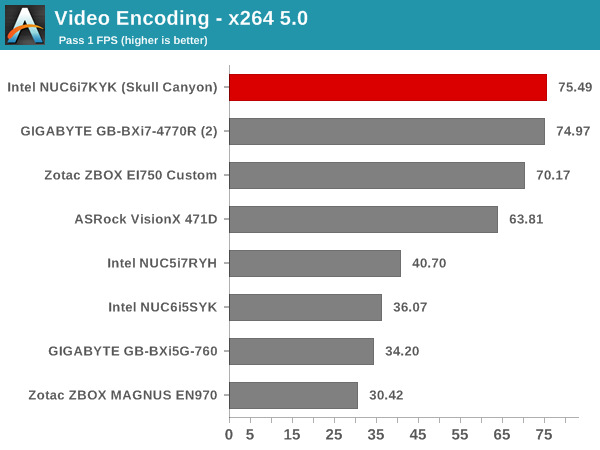
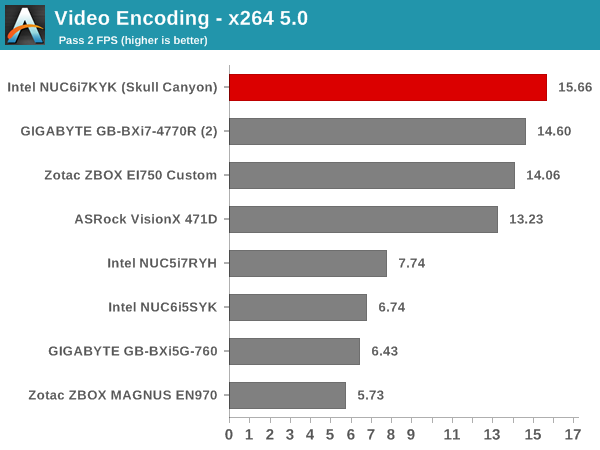
7-Zip
7-Zip is a very effective and efficient compression program, often beating out OpenCL accelerated commercial programs in benchmarks even while using just the CPU power. 7-Zip has a benchmarking program that provides tons of details regarding the underlying CPU's efficiency. In this subsection, we are interested in the compression and decompression MIPS ratings when utilizing all the available threads. This workload doesn't show the benefits evident in the previous section, with systems using the 65W TDP CPUs getting a slight lead over the NUC6i7KYK.
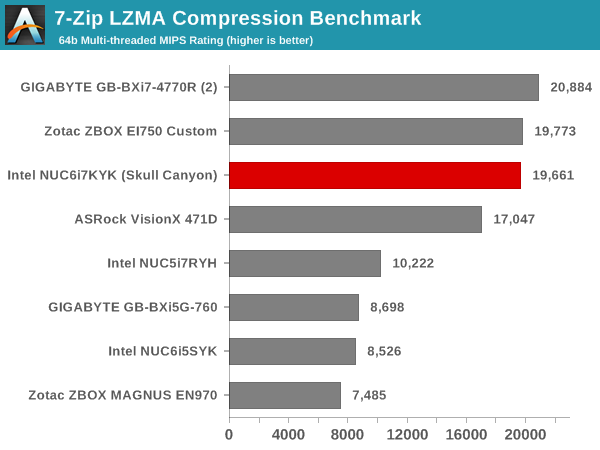
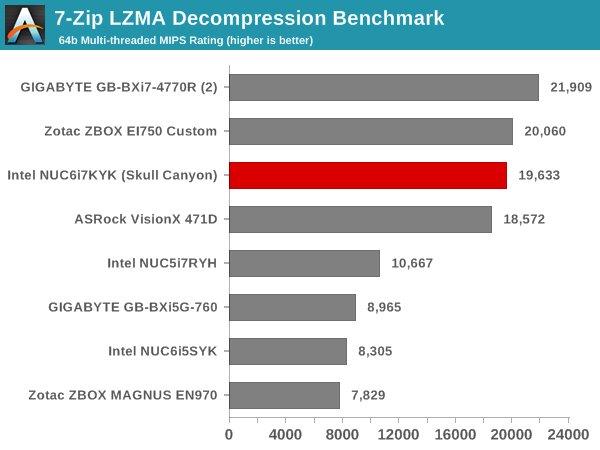
TrueCrypt
As businesses (and even home consumers) become more security conscious, the importance of encryption can't be overstated. Intel CPUs supporting the AES-NI instruction have acceleration for the encryption and decryption processes. The Core i7-6770HQ in the NUC6i7KYK does have AES-NI support. TrueCrypt, a popular open-source disk encryption program can take advantage of the AES-NI capabilities. The TrueCrypt internal benchmark provides some interesting cryptography-related numbers. In the graph below, we can get an idea of how fast a TrueCrypt volume would behave in the Intel NUC6i7KYK (Skull Canyon) and how it would compare with other select PCs. This is a purely CPU feature / clock speed based test.
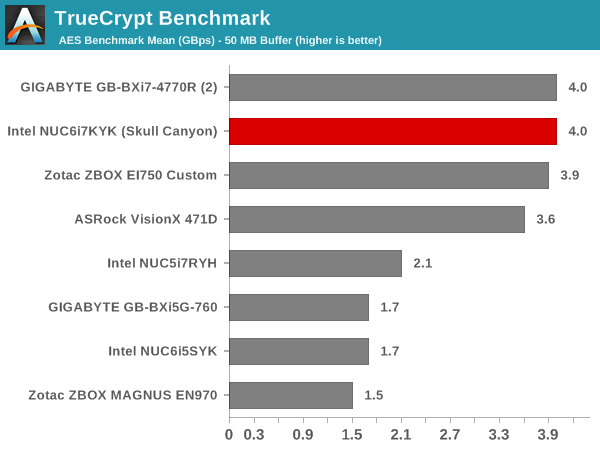
Agisoft Photoscan
Agisoft PhotoScan is a commercial program that converts 2D images into 3D point maps, meshes and textures. The program designers sent us a command line version in order to evaluate the efficiency of various systems that go under our review scanner. The command line version has two benchmark modes, one using the CPU and the other using both the CPU and GPU (via OpenCL). The benchmark takes around 50 photographs and does four stages of computation:
- Stage 1: Align Photographs
- Stage 2: Build Point Cloud (capable of OpenCL acceleration)
- Stage 3: Build Mesh
- Stage 4: Build Textures
We record the time taken for each stage. Since various elements of the software are single threaded, others multithreaded, and some use GPUs, it is interesting to record the effects of CPU generations, speeds, number of cores, DRAM parameters and the GPU using this software.
The combination of CPU power and EDRAM helps the compute capabilities when it comes to OpenCL acceleration in the second stage of the benchmark. Only the ASRock VisionX 471D with an AMD GPU performs better. Skull Canyon is placed in the top two in all the CPU-intensive stages.
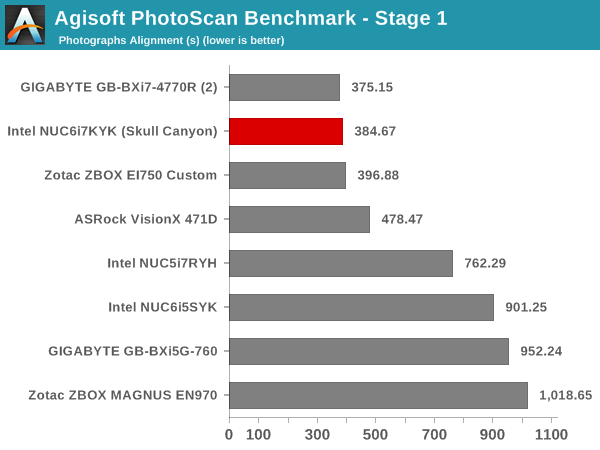
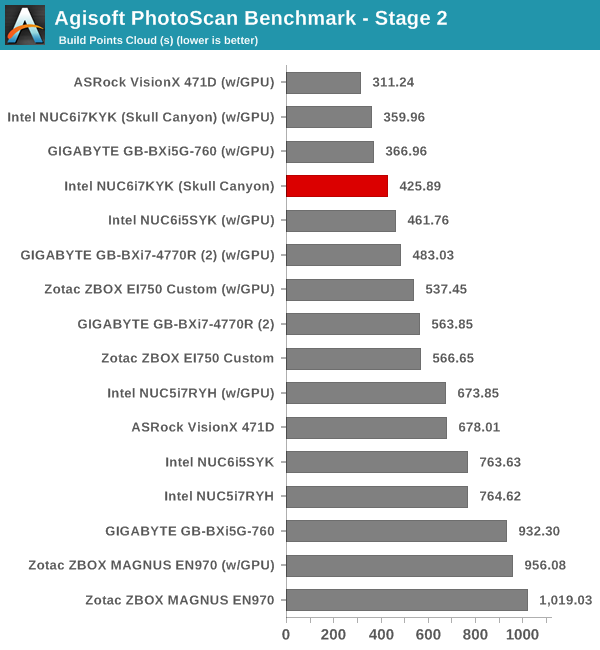
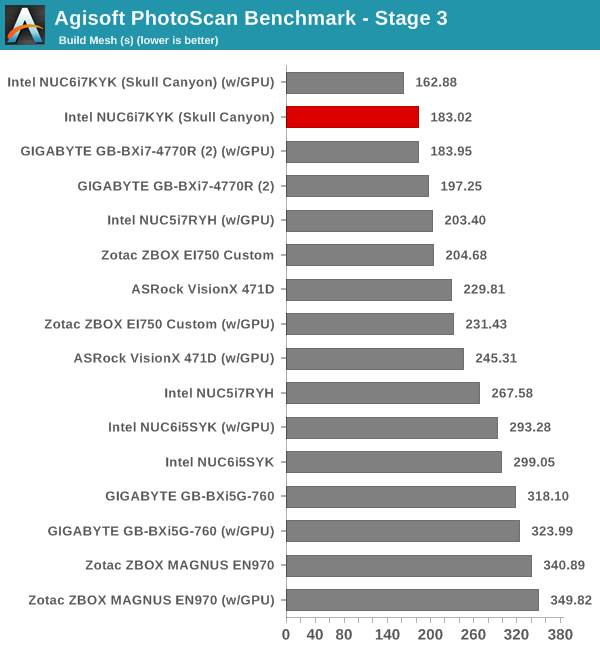
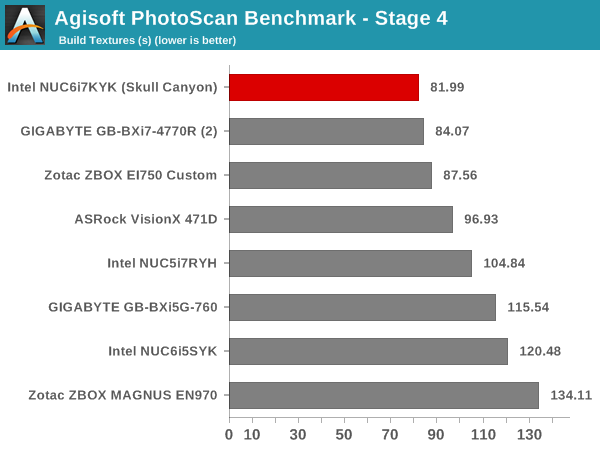
Dolphin Emulator
Wrapping up our application benchmark numbers is the Dolphin Emulator benchmark mode results. This is again a test of the CPU capabilities, and this workload favors the 65W TDP CPUs. The architectural changes in Skylake are not enough to overcome the benefits provided by the higher-clock speed of the Core i7-4770R.
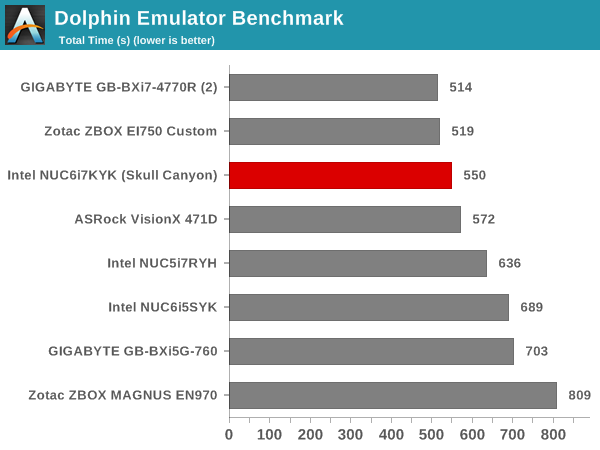
Gaming Benchmarks
Intel's Iris Pro Graphics SKUs with integrated EDRAM are amongst the highest-performing iGPUs in the market right now. The Core i7-6770HQ is equipped with Intel Iris Pro Graphics 580 - a GT4e part with 72 EUs and 128MB of eDRAM.
For the purpose of benchmarking, we chose six different games (Sleeping Dogs, Tomb Raider, Bioshock Infinite, The Talos Principle, GRID Autosport and DiRT Showdown) at various quality levels. The purpose of this section is not to benchmark the latest and greatest games, or benchmark at 4K resolutions. Intel clearly targets the Skull Canyon NUC towards casual gamers and those wanting to get introduced to mainstream gaming titles. As such, it is expected that people would play games with medium settings at 1080p or lower resolutions.
Sleeping Dogs
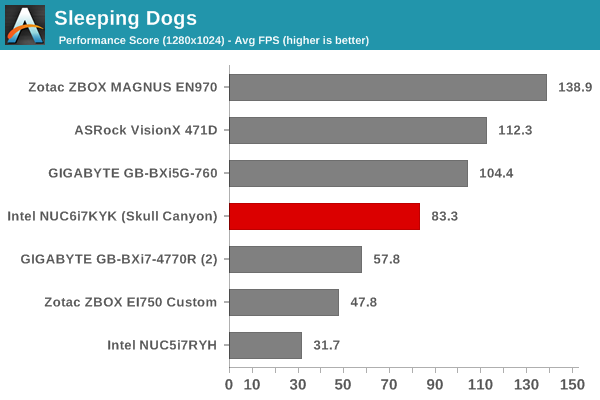
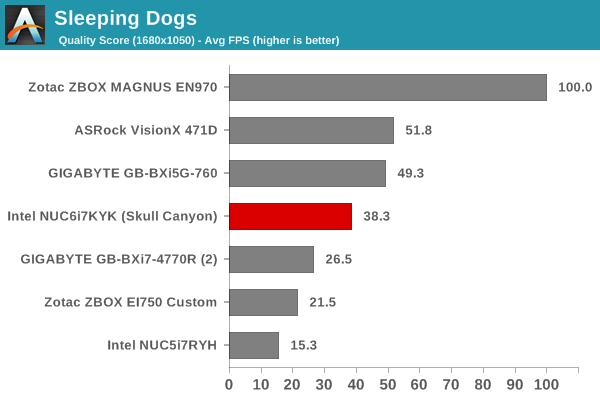
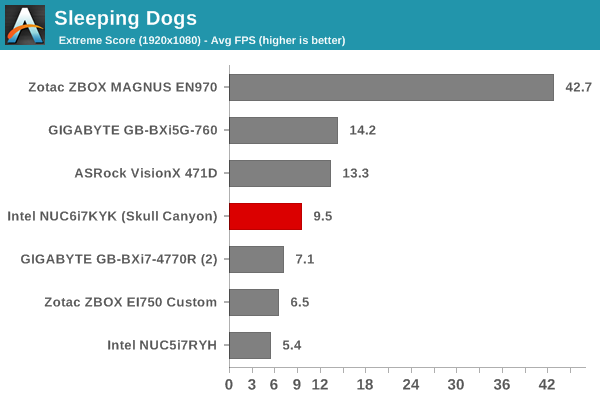
Tomb Raider
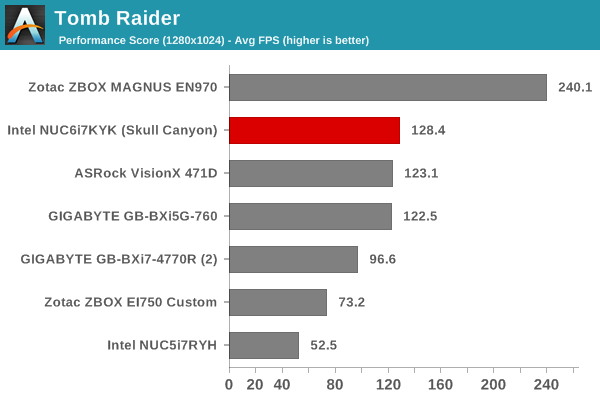
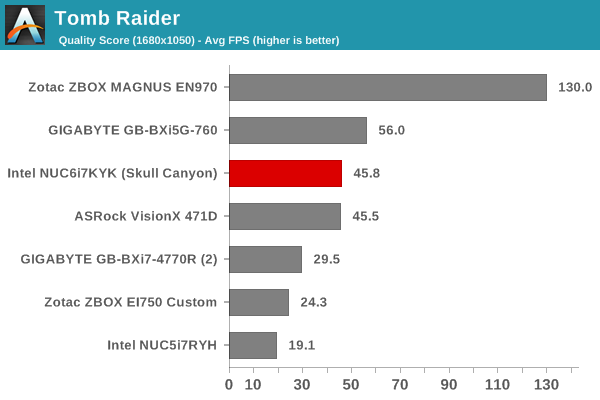
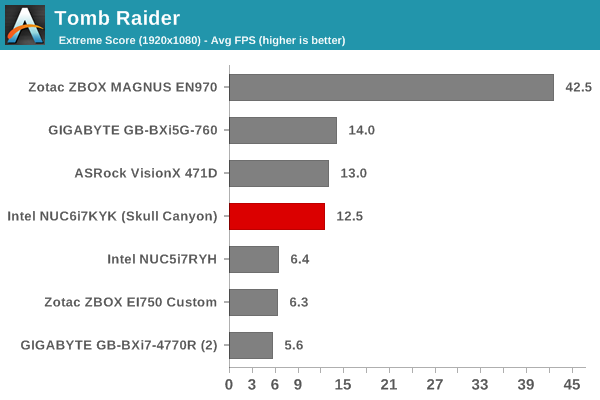
Bioshock Infinite
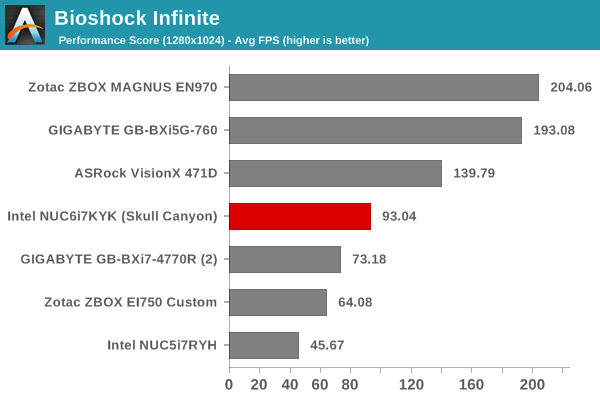
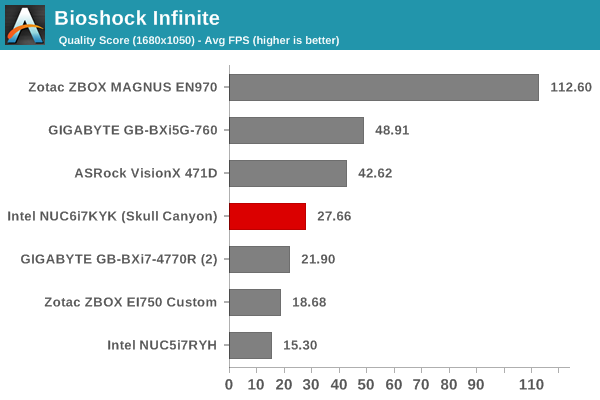
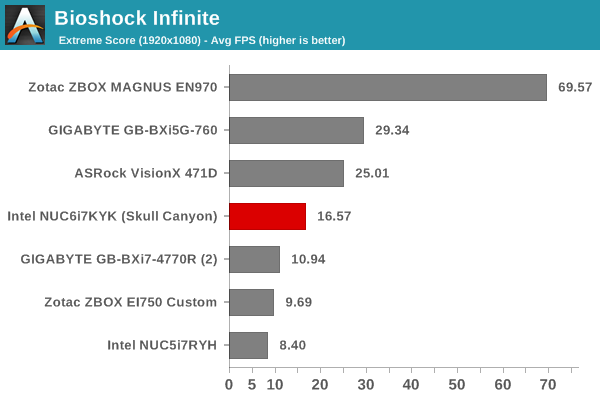
DiRT Showdown
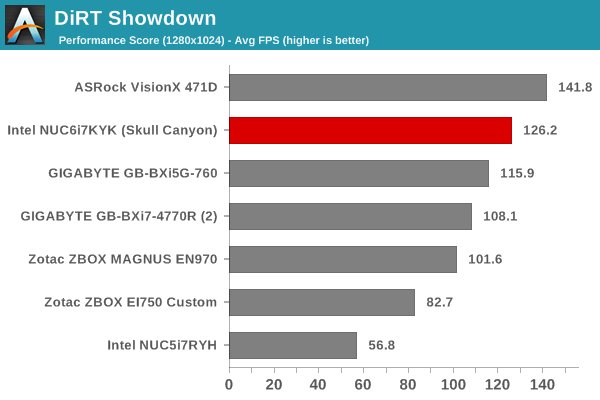
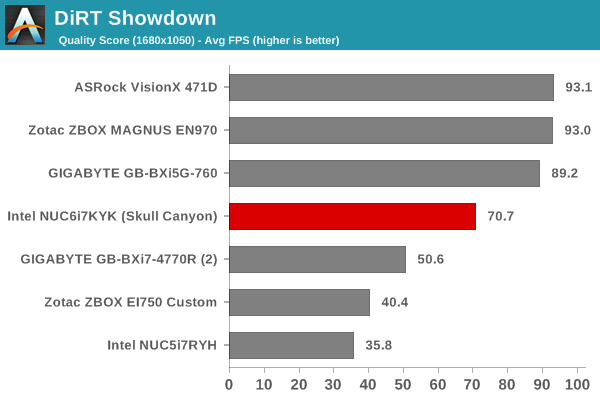
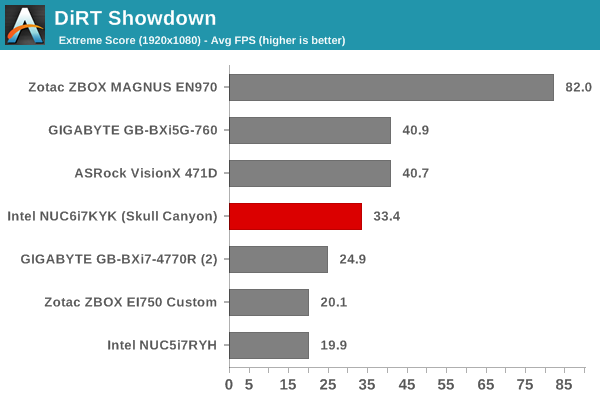
The Talos Principle
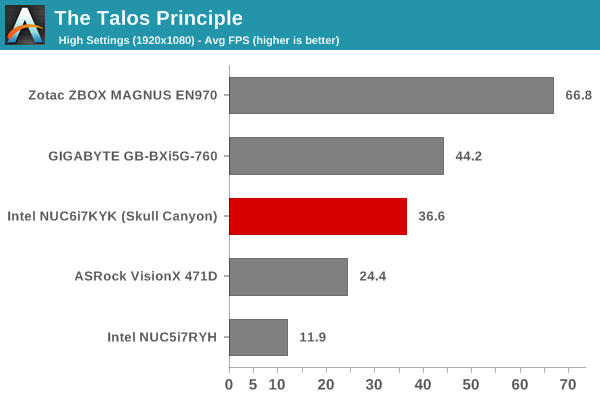
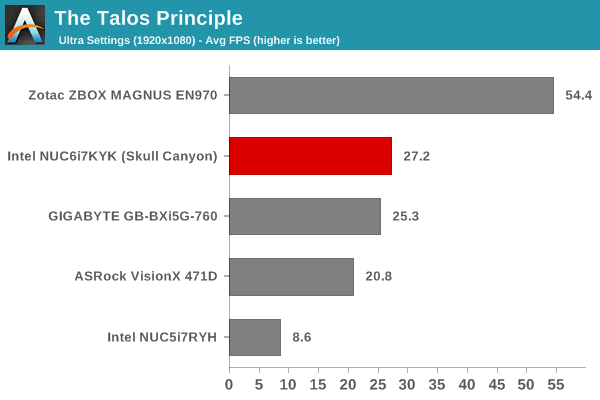
GRID Autosport
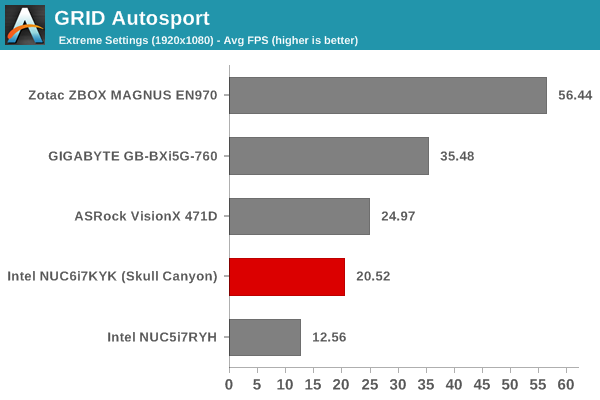
All the numbers point to expected results - Skull Canyon is simply the best when it comes to having the best iGPU for gaming purposes. However, it is a bit of a disappointment when compared to systems having slightly bigger footprints, but, equipped with previous generation discrete mobile GPUs. An external Thunderbolt GPU dock can solve some of the issues for users wanting more graphics prowess than what the Iris Pro Graphics 580 can deliver, but that has a significant price premium, and it is not something that we evaluated as part of this review.
Networking and Storage Performance
Networking and storage are two major aspects which influence our experience with any computing system. This section presents results from our evaluation of these aspects in the Intel NUC6i7KYK (Skull Canyon). On the storage side, one option would be repetition of our strenuous SSD review tests on the drive(s) in the PC. Fortunately, to avoid that overkill, PCMark 8 has a storage bench where certain common workloads such as loading games and document processing are replayed on the target drive. Results are presented in two forms, one being a benchmark number and the other, a bandwidth figure. We ran the PCMark 8 storage bench on selected PCs and the results are presented below.
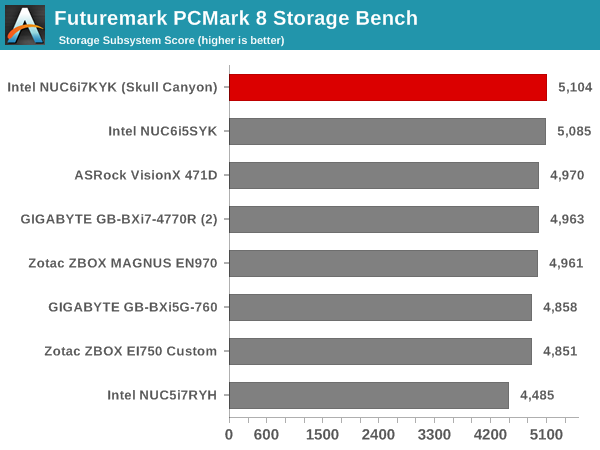
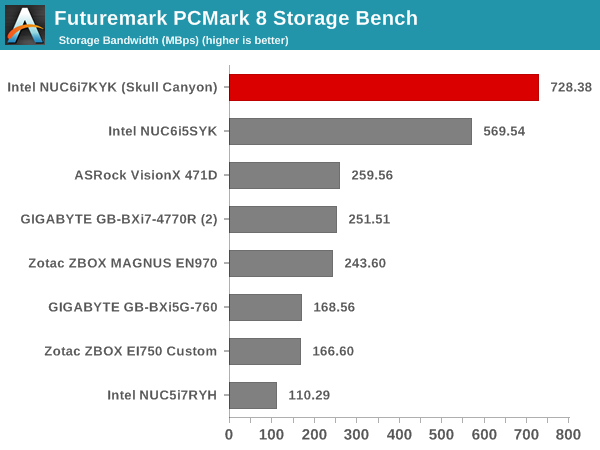
The storage score (primary result) shows that there is not much to gain by going from the SM951 in the NUC6i5SYK to the 950 PRO in the NUC6i7KYK. It shows that workloads are more user-input and CPU-bound, rather than storage-bound. On the other hand, the storage bandwidth number (secondary result) shows a significant jump. Readers can refer to our explanation of how these numbers are calculated by PCMark 8. The secondary result is the total amount of data transferred (both reads and writes) divided by the storage I/O busy time (i.e, time duration during which the number of pending I/O operations was at least 1). The secondary result is a very important metric when idle time compression is involved, but it doesn't matter as much as the primary result when it comes to application responsiveness (as the workload might be CPU-bound, rather than storage-bound). In any case, the above result shows that a powerful CPU can drive up the secondary result very high.
On the networking side, we restricted ourselves to the evaluation of the WLAN component. Our standard test router is the Netgear R7000 Nighthawk configured with both 2.4 GHz and 5 GHz networks. The router is placed approximately 20 ft. away, separated by a drywall (as in a typical US building). A wired client (Zotac ID89-Plus) is connected to the R7000 and serves as one endpoint for iperf evaluation. The PC under test is made to connect to either the 5 GHz (preferred) or 2.4 GHz SSID and iperf tests are conducted for both TCP and UDP transfers. It is ensured that the PC under test is the only wireless client for the Netgear R7000. We evaluate total throughput for up to 32 simultaneous TCP connections using iperf and present the highest number in the graph below.
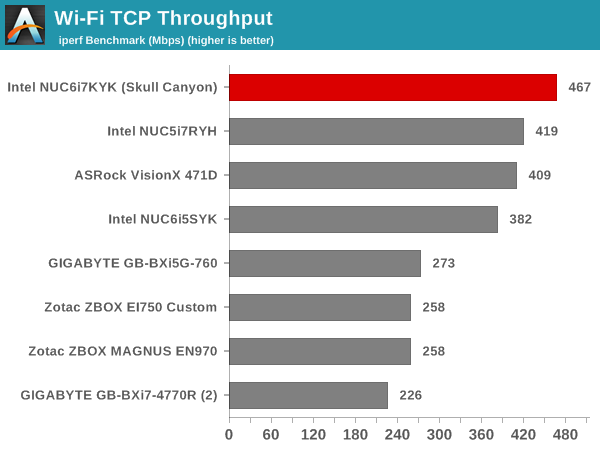
In the UDP case, we try to transfer data at the highest rate possible for which we get less than 1% packet loss.
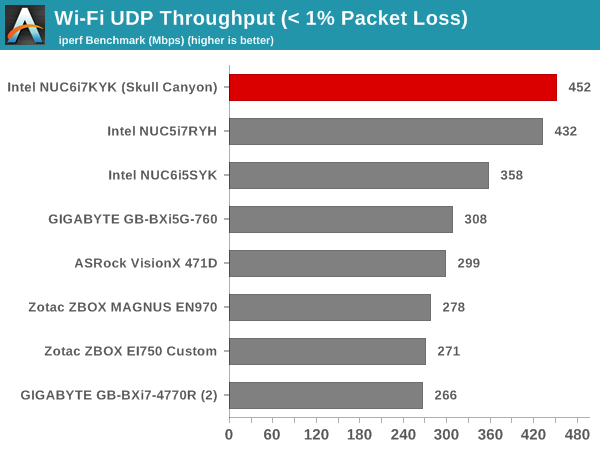
The antenna placement and the system design ensure that the Intel 802.11ac AC8260 WLAN subsystem performs exceptionally well in our Wi-Fi testing and comes out at the top of the charts in both TCP and UDP tests.
HTPC Credentials
The higher TDP of the processor in Skull Canyon, combined with the new chassis design, makes the unit end up with a bit more noise compared to the traditional NUCs. It would be tempting to say that the extra EUs in the Iris Pro Graphics 580, combined with the eDRAM, would make GPU-intensive renderers such as madVR operate more effectively. That could be a bit true in part (though, madVR now has a DXVA2 option for certain scaling operations), but, the GPU still doesn't have full HEVC 10b decoding, or stable drivers for HEVC decoding on WIndows 10. In any case, it is still worthwhile to evaluate basic HTPC capabilities of the Skull Canyon NUC6i7KYK.
Refresh Rate Accurancy
Starting with Haswell, Intel, AMD and NVIDIA have been on par with respect to display refresh rate accuracy. The most important refresh rate for videophiles is obviously 23.976 Hz (the 23 Hz setting). As expected, the Intel NUC6i7KYK (Skull Canyon) has no trouble with refreshing the display appropriately in this setting.
The gallery below presents some of the other refresh rates that we tested out. The first statistic in madVR's OSD indicates the display refresh rate.
Network Streaming Efficiency
Evaluation of OTT playback efficiency was done by playing back our standard YouTube test stream and five minutes from our standard Netflix test title. Using HTML5, the YouTube stream plays back a 1080p H.264 encoding. Since YouTube now defaults to HTML5 for video playback, we have stopped evaluating Adobe Flash acceleration. Note that only NVIDIA exposes GPU and VPU loads separately. Both Intel and AMD bundle the decoder load along with the GPU load. The following two graphs show the power consumption at the wall for playback of the HTML5 stream in Mozilla Firefox (v 46.0.1).
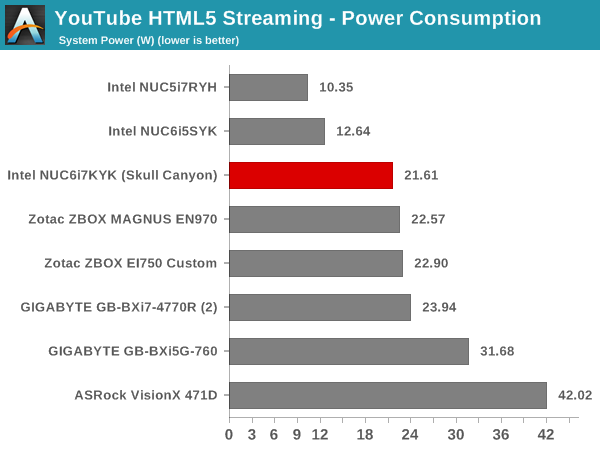
GPU load was around 13.71% for the YouTube HTML5 stream and 0.02% for the steady state 6 Mbps Netflix streaming case. The power consumption of the GPU block was reported to be 0.71W for the YouTube HTML5 stream and 0.13W for Netflix.
Netflix streaming evaluation was done using the Windows 10 Netflix app. Manual stream selection is available (Ctrl-Alt-Shift-S) and debug information / statistics can also be viewed (Ctrl-Alt-Shift-D). Statistics collected for the YouTube streaming experiment were also collected here.
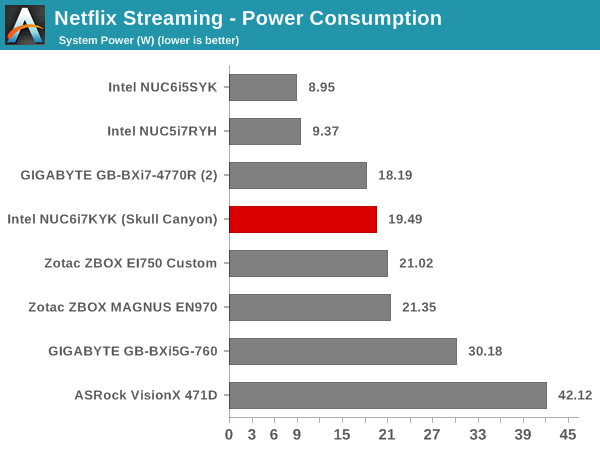
Decoding and Rendering Benchmarks
In order to evaluate local file playback, we concentrate on EVR-CP, madVR and Kodi. We already know that EVR works quite well even with the Intel IGP for our test streams. Under madVR, we used the DXVA2 scaling logic (as Intel's fixed-function scaling logic triggered via DXVA2 APIs is known to be quite effective). We used MPC-HC 1.7.10 x86 with LAV Filters 0.68.1 set as preferred in the options. In the second part, we used madVR 0.90.19.
In our earlier reviews, we focused on presenting the GPU loading and power consumption at the wall in a table (with problematic streams in bold). Starting with the Broadwell NUC review, we decided to represent the GPU load and power consumption in a graph with dual Y-axes. Nine different test streams of 90 seconds each were played back with a gap of 30 seconds between each of them. The characteristics of each stream are annotated at the bottom of the graph. Note that the GPU usage is graphed in red and needs to be considered against the left axis, while the at-wall power consumption is graphed in green and needs to be considered against the right axis.
Frame drops are evident whenever the GPU load consistently stays above the 85 - 90% mark. We did not hit that case with any of our test streams. Note that we have not moved to 4K officially for our HTPC evaluation. We did check out that HEVC 8b decoding works well (even 4Kp60 had no issues), but HEVC 10b hybrid decoding was a bit of a mess - some clips worked OK with heavy CPU usage, while other clips tended to result in a black screen (those clips didn't have any issues with playback using a GTX 1080).
Moving on to the codec support, the Intel Iris Pro Graphics 580 is a known quantity with respect to the scope of supported hardware accelerated codecs. DXVA Checker serves as a confirmation for the features available in driver version 15.40.23.4444.
It must be remembered that the HEVC_VLD_Main10 DXVA profile noted above utilizes hybrid decoding with both CPU and GPU resources getting taxed.
On a generic note, while playing back 4K videos on a 1080p display, I noted that madVR with DXVA2 scaling was more power-efficient compared to using the EVR-CP renderer that MPC-HC uses by default.
Power Consumption and Thermal Performance
The power consumption at the wall was measured with a 1080p display being driven through the HDMI port. In the graphs below, we compare the idle and load power of the Intel NUC6i7KYK (Skull Canyon) with other low power PCs evaluated before. For load power consumption, we ran Furmark 1.12.0 and Prime95 v27.9 together. The idle number is a bit disappointing, though, I assume that a change in the BIOS to the low power profile could help improve things. Otherwise, the idle number is just slightly higher than what is typical for a system with a 45W TDP CPU and a PCIe M.2 SSD.
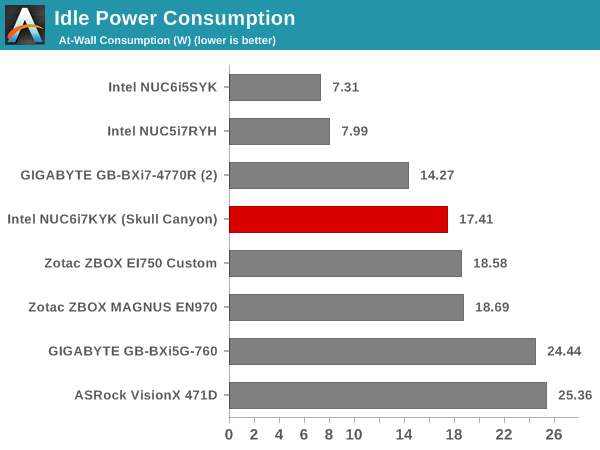
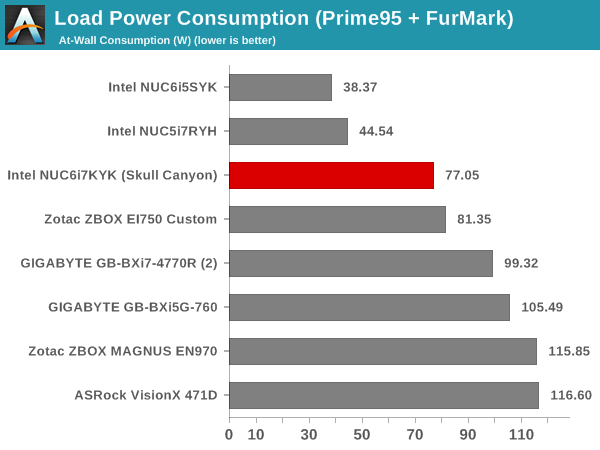
The load power number in the graph above is the maximum sustained value. As we can see from the graphs below, instantaneous peak numbers can go as high as 95W. Addition of bus-powered USB devices will also tend to drive up this number further.
Our thermal stress routine starts with the system at idle, followed by 30 minutes of pure CPU loading. This is followed by another 30 minutes of both CPU and GPU being loaded simultaneously. After this, the CPU load gets removed, allowing the GPU to be loaded alone for another 30 minutes. The various clocks in the system as well as the temperatures within the unit are presented below.
The graph below present the power consumption profile of various blocks in the CPU package during the course of our thermal stress. Following that, we have the power consumption at the wall for the system during the same period.
According to the official specifications, the junction temperature of the Core i7-6770HQ is 100 C. Unfortunately, the cooling solution is not able to prevent the CPU from hitting it with turbo speeds activated. However, the frequency does remain above the base 2.6 GHz throughout the pure CPU loading segment. The package power settles down to a steady 45W, and that continues throughout the duration of our test. Our only concern is that the cooling solution keeps the temperature of the cores too close to the junction temperature during periods of heavy CPU load. Once the load gets distributed across both the CPU and the GPU, we see the package come down to around 90C.
Another important aspect to keep note of while evaluating mini-PCs is the chassis temperature. Using the Android version of the FLIR One thermal imager, we observed the chassis temperature after the CPU package temperature reached the steady state value in the above graph.
We have additional thermal images in the gallery below.
The maximum chassis temperature observed by the thermal imager was slightly above 60 C near the fan's exhaust vent. At that point, a sound level Android app running on the HTC One M7 recorded 59 dB. For comparison purposes, the Zotac ZBOX MAGNUS EN970 recorded 50 dB in a similar scenario.
Miscellaneous Aspects and Concluding Remarks
One of the more impressive aspects of the Skull Canyon NUC6i7KYK is the reappearance of Thunderbolt in a mini-PC. We have already covered Thunderbolt 3 in good detail. From the perspective of a Skull Canyon evaluation, the Thunderbolt 3 port does deserve a bit of attention. It must be noted that this USB Type-C port can also act as a USB 3.1 Gen 2 host port. Our evaluation of this feature is in two parts - we first hooked up a SanDisk Extreme 900 1.92TB USB 3.1 Gen 2 SSD and ran a quick speed test. We were able to see results similar to our review numbers, indicating that the USB 3.1 Gen 2 mode was indeed active. For the Thunderbolt part, we decided to check out Thunderbolt networking with our direct-attached storage testbed.
A Thunderbolt cable between two PCs is enough to create a Thunderbolt network
Connecting the Thunderbolt ports on the two machines and allowing the PCs to talk to each other automatically creates a 10Gbps network adapter. For a setup with just two machines, it is enough to just set static IPs on the interfaces of both machines in the same subnet, and setting the network location to private so that the machines can talk to each other. We configured a RAM drive on the testbed and mapped it as a network drive on the NUC6i7KYK, Running CrystalDiskMark on the mapped drive showed read speeds of 700 MBps and write speeds of 620 MBps, indicative of a 10Gbps link. The gallery below presents some screenshots of the benchmarks as well as the Thunderbolt networking setup steps.
Moving on to the business end of the review, let us get the complaints out of the way - While the size and form-factor of Skull Canyon are impressive, the acoustic profile is not that great. We would gladly trade a modest increase in the footprint of the system for lower fan noise. That said, the fan noise is in no way comparable to the BRIX Gaming lineup. It is just that it is not as silent as the traditional NUCs.
On the board layout front, we are unable to fathom why the CPU's PCIe lanes are not used at all. It would have been great to have a dual-port Alpine Ridge controller hang directly off the CPU's PCIe lanes. Finally, the ports on the chassis could have done with better spread. The two pairs of USB ports are such that one occupied port ends up making it difficult to utilize the other one in the pair. A port on one of the sides, or, on the lid (without relying on third-party designs), would be very welcome.
But with the above caveats in mind, Skull Canyon is definitely a great product. Simply put, it packs the most punch among systems with similar footprints. It is excellent for casual gamers, but, unfortunately, stops short of being a replacement for systems like the Zotac ZBOX MAGNUS EN970 or the ASRock VisionX 471D - two small form-factor PCs that integrate discrete GPUs at the cost of a larger footprint compared to Skull Canyon. The Thunderbolt 3 port, with an external GPU dock, can somewhat make up for the lack of a discrete GPU for gamers. However, the cost factor becomes a major issue. The 4C/8T configuration of the Core i7-6770HQ is also attractive to consumers looking for a small form-factor system with a powerful CPU, but, they must remember that some price premium is being paid for the Iris Pro graphics.
I am actually looking forward to what vendors like Zotac and ASRock can do with a similar design. If they could take a Skylake-H processor without Iris Pro (say, Core i7-6820HQ), and use the PCIe lanes off the CPU to hook up a mobile discrete GPU, it could deliver the best of both worlds - all the 45W TDP of the CPU can be used to provide raw processing power for CPU-intensive workloads, while a dGPU can handle graphics duties with a separate power budget.
To summarize, Intel has indeed managed to change the game with the NUC6i7KYK. A look at the increase in the gaming capabilities over the previous generation 'gaming' NUCs make the Skull Canyon updates to appear evolutionary in nature. However, the overall platform capabilities (including a much more powerful -H series CPU instead of a -U series CPU, as well as the integration of Thunderbolt 3 and dual M.2 PCIe 3.0 x4 SSD slots) are enough to justify the price premium ($650 for the barebones configuration).

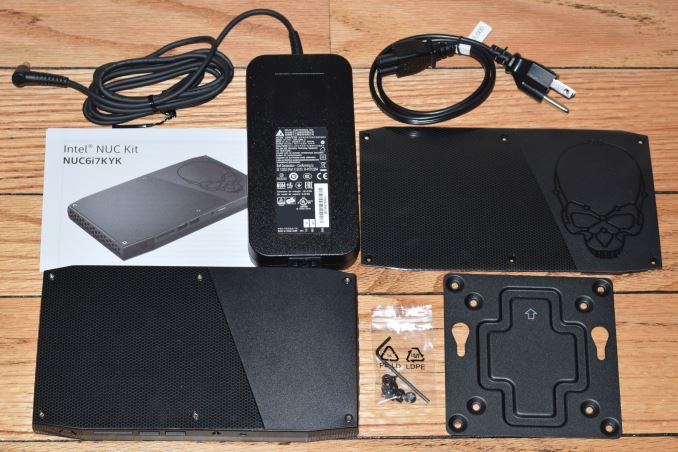






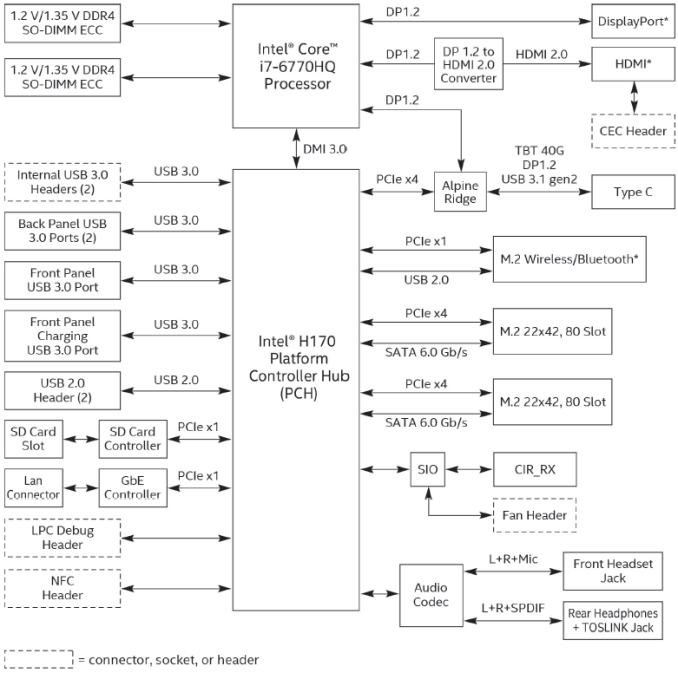












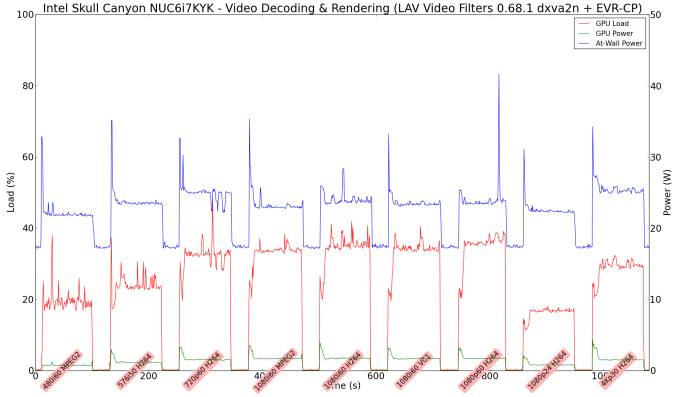
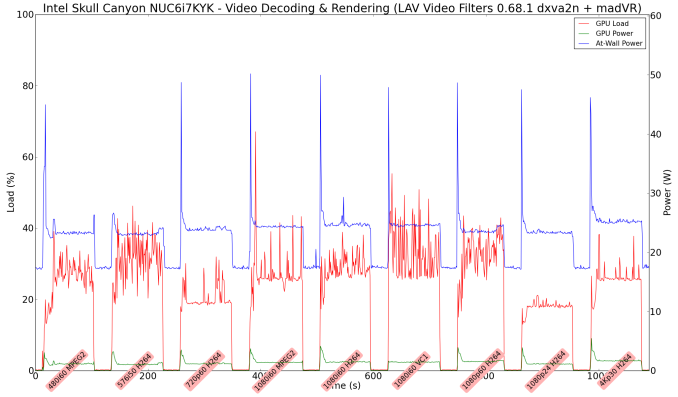
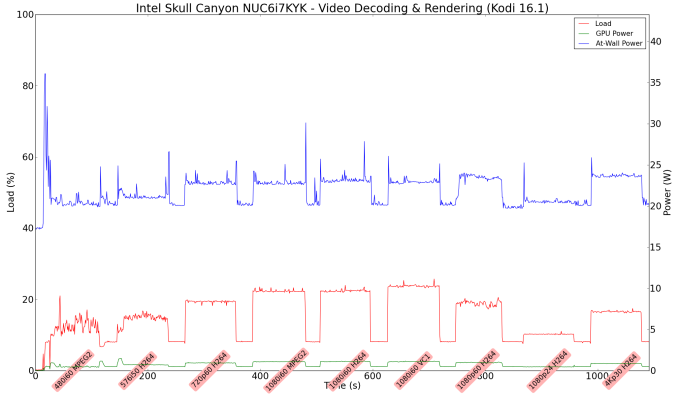
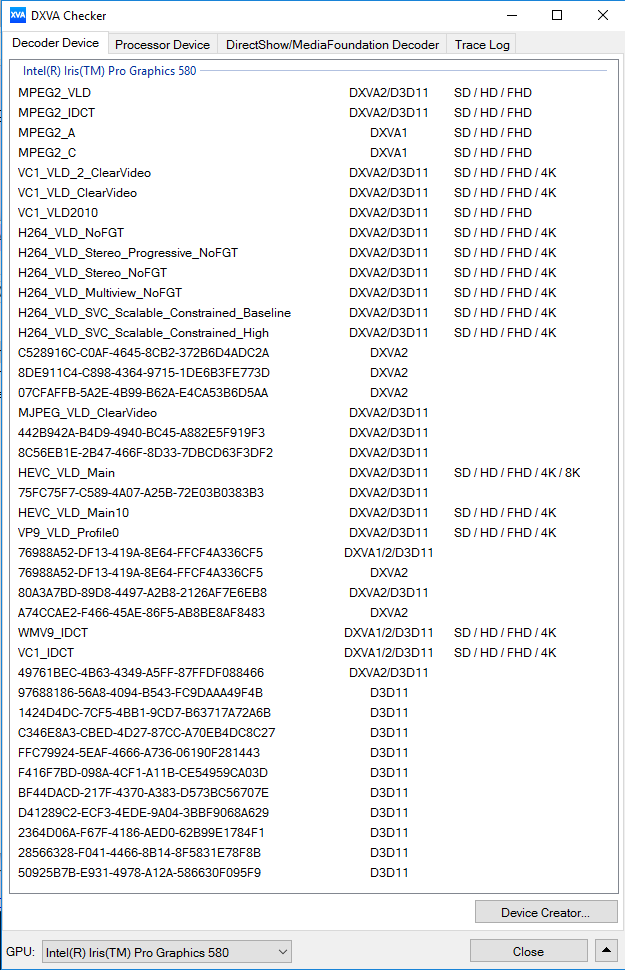
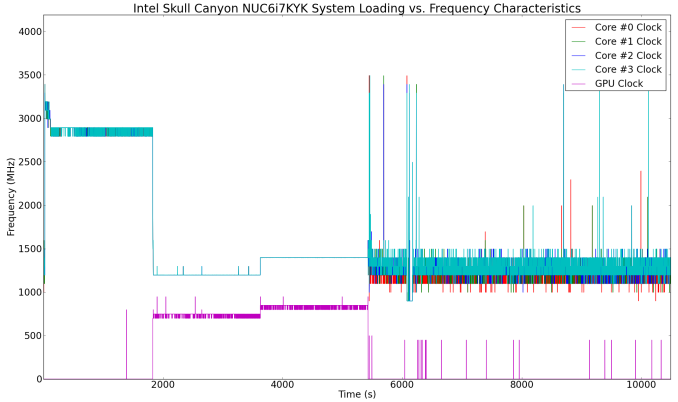
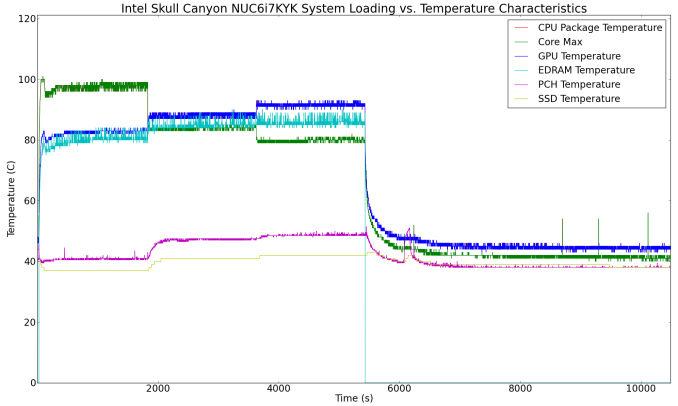
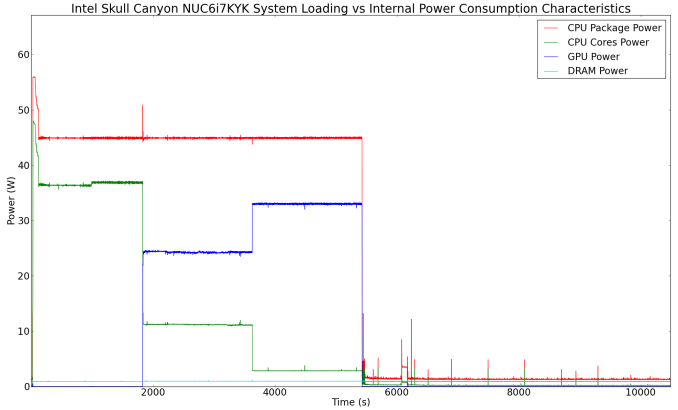
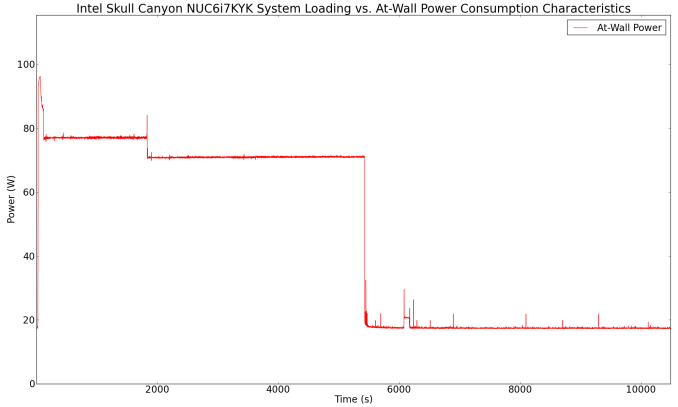
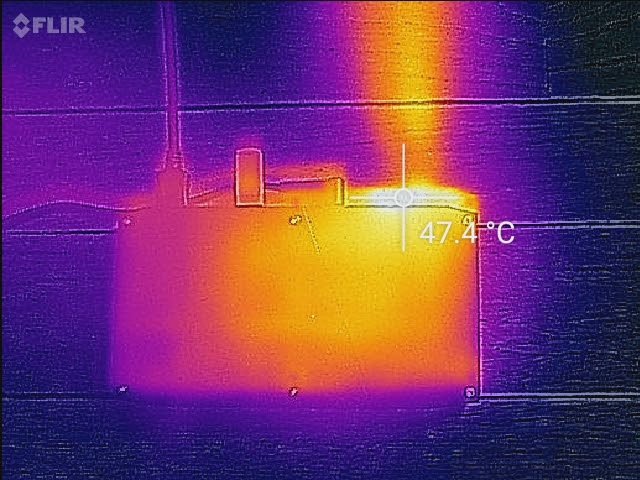
_thumb.jpg)

_thumb.jpg)

_thumb.jpg)

